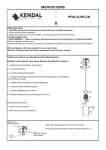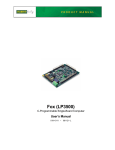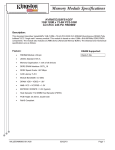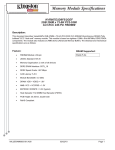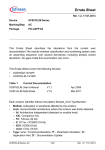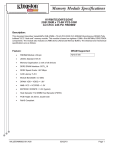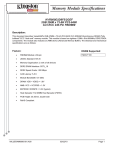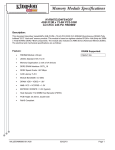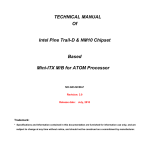Download User Manual EVA-X4300
Transcript
User Manual EVA-X4300 System Design Guide Copyright Advantech reserves the right to make changes without further notice to any products or data herein to improve reliability, function, or design. Information furnished by Advantech is believed to be accurate and reliable. However, Advantech does not assure any liability arising out of the application or use of this information, nor the application or use of any product or circuit described herein, neither does it convey any license under its patent rights nor the rights of others. Copyright © 2008 Advantech Co., Ltd. All rights reserved. Part No. 2006X43020 Edition 1 Printed in Taiwan August 2008 EVA-X4300 System Design Guide ii Contents Chapter 1 Overview...............................................1 1.1 Overview ................................................................................................... 2 2 Layout Guide........................................3 2.1 2.2 2.3 2.4 2.5 2.6 2.7 2.8 2.9 2.10 2.11 2.12 2.13 BGA Layout Guideline............................................................................... 4 Package Outline........................................................................................ 6 Signal Arrangement .................................................................................. 8 EVA-X4300 Power Requirement............................................................. 11 General Layout Rule ............................................................................... 11 Crystal / External Oscillator..................................................................... 15 DDR2 Interface ....................................................................................... 16 Switching Power...................................................................................... 19 PCI Interface ........................................................................................... 20 USB 2.0................................................................................................... 21 IDE .......................................................................................................... 23 LPC Interface .......................................................................................... 24 10/100 LAN ............................................................................................. 25 Appendix A References .........................................29 A.1 References.............................................................................................. 30 Chapter iii EVA-X4300 System Design Guide EVA-X4300 System Design Guide iv Chapter 1 Overview 1 1.1 Overview The EVA-X4300 is a fully static 32-bit x86-based processor that is compatible with a wide-range of PC peripherals, applications and operating systems, such as DOS, WinCE, Linux, and most popular 32-bit RTOSs (Real Time OS). It enables maximum software re-use based on its feature of legacy compatibility. The EVA-X4300 integrates 32 KB write-through direct map L1 cache, a PCI bus interface at 33 MHz, an 8/ 16-bit ISA bus interface, SDR SDRAM, DDR2 SDRAM, a ROM controller, IPC (Internal Peripheral Controller) with DMA and interrupt timer/counter included, FIFO UART, SPI (Serial Peripheral Interface), LPC (low pin count), a USB 1.1/2.0 host controller, LoC (LAN on Chip), an IDE controller, and 256 KB flash within a single 581-pin BGA package to form a an SoC (System-on-Chip) processor. The EVA-X4300 integrates comprehensive features and rich I/O flexibility within a single System-on-Chip, to reduce board design complexity and shorten product development schedules. Taking advantage of ultra low power consumption, the EVA-X4300 is able to operate in a wide range of temperatures without additional thermal design. With the commitment of long term supply guaranteed for the EVA-X4300, customers can extend product life cycle and receive a maximum return on investment. The EVA-X4300 provides an ideal solution for embedded systems and communication products (such as the thin client, NAT router, home gateway, access point and tablet PC) producing optimal performance. This system design guide provides detailed usage information of the highly integrated EVA-X4300 SoC processor. EVA-X4300 System Design Guide 2 Chapter 2 Layout Guide 2 2.1 BGA Layout Guideline The package of EVA-X4300 is 581-ball PBGA. The ball diameter is 0.6 mm (24 mil); ball pitch is 1 mm (40 mil). There are 6 rows of balls arranged along the edge of the package. For 6-layer: ! Ball pad diameter: 24 mil ! Traces width/ spacing for Signals: 5.5/ 5 mil ! Trace width for Power and Ground: 20 mils ! Vias PAD/ Drill diameter for all Signals: 14/ 8 mil ! Via-to-via spacing (center to center): 40 mil ! Via-to-pad spacing (center to center): 30 mil EVA-X4300 System Design Guide 4 Chapter 2 For 4-layer: ! Ball pad diameter: 14 mil ! Traces width/ spacing for Signals: 5/ 5 mil ! Trace width for Power and Ground: 20 mils ! Vias PAD/ Drill diameter for all Signals: 22/ 12 mil ! Via-to-via spacing (center to center): 40 mil ! Via-to-pad spacing (center to center): 30 mil Layout Guide Note! All the Vias must be covered by solder mask. To minimize inductance, power vias should be as large as possible and take good care of the inadvertently cut of the ground and power planes. 5 EVA-X4300 System Design Guide 2.2 Package Outline EVA-X4300 System Design Guide 6 Chapter 2 Layout Guide 7 EVA-X4300 System Design Guide 2.3 Signal Arrangement Top View 26 ○ ○ ○ ○ ○ ○ 25 ○ ○ ○ ○ ○ ○ 24 ○ ○ ○ ○ ○ ○ 23 ○ ○ ○ ○ ○ ○ ○ ○ ○ ○ ○ ○ ○ ○ ○ ○ ○ ○ ○ ○ ○ ○ ○ ○ ○ ○ ○ ○ ○ ○ ○ ○ ○ ○ ○ ○ ○ ○ ○ ○ ○ ○ ○ ○ ○ ○ ○ ○ ○ ○ ○ ○ ○ ○ ○ ○ ○ ○ ○ ○ ○ ○ ○ ○ ○ ○ ○ ○ ○ ○ ○ ○ ○ ○ ○ ○ ○ ○ ○ ○ ○ ○ 22 ○ ○ ○ ○ ○ ○ ○ ○ ○ ○ ○ ○ ○ ○ ○ ○ ○ ○ ○ ○ ○ ○ 22 ○ ○ ○ ○ ○ ○ ○ ○ ○ ○ ○ ○ ○ ○ ○ ○ ○ ○ ○ ○ ○ ○ 20 ○ ○ ○ ○ ○ ○ ○ ○ 19 ○ ○ ○ ○ ○ ○ ○ ○ 18 ○ ○ ○ ○ ○ ○ ○ ○ ○ ○ ○ ○ ○ ○ ○ ○ ○ ○ ○ ○ ○ ○ ○ ○ ○ ○ ○ ○ ○ ○ ○ ○ ○ ○ ○ ○ ○ ○ ○ ○ ○ ○ 17 ○ ○ ○ ○ ○ ○ 16 ○ ○ ○ ○ ○ ○ 15 ○ ○ ○ ○ ○ ○ 14 ○ ○ ○ ○ ○ ○ ○ ○ ○ ○ ○ ○ ○ ○ ○ ○ ○ ○ ○ ○ ○ ○ ○ ○ ○ ○ ○ ○ ○ ○ ○ ○ ○ ○ ○ ○ ○ ○ ○ ○ ○ ○ ○ ○ ○ ○ ○ ○ ○ ○ ○ ○ ○ ○ ○ ○ ○ ○ ○ ○ ○ ○ ○ ○ ○ ○ ○ ○ ○ ○ 13 ○ ○ ○ ○ ○ ○ 12 ○ ○ ○ ○ ○ ○ 11 ○ ○ ○ ○ ○ ○ 10 ○ ○ ○ ○ ○ ○ ○ ○ ○ ○ ○ ○ ○ ○ ○ ○ ○ ○ ○ ○ ○ ○ ○ ○ ○ ○ ○ ○ ○ ○ ○ ○ ○ ○ ○ ○ ○ ○ ○ ○ ○ ○ ○ ○ ○ ○ ○ ○ ○ ○ ○ ○ ○ ○ ○ ○ ○ ○ ○ ○ ○ ○ ○ ○ ○ ○ ○ ○ ○ ○ 9 ○ ○ ○ ○ ○ ○ ○ ○ ○ 8 ○ ○ ○ ○ ○ ○ 7 ○ ○ ○ ○ ○ ○ ○ 6 ○ ○ ○ ○ ○ ○ ○ ○ ○ ○ ○ 5 ○ ○ ○ ○ ○ ○ ○ ○ ○ ○ ○ 4 ○ ○ ○ ○ ○ ○ ○ ○ ○ ○ ○ 3 ○ ○ ○ ○ ○ ○ 2 ○ ○ ○ ○ ○ ○ 1 ○ ○ ○ ○ ○ ○ A B C D E F ○ ○ ○ ○ ○ ○ ○ ○ ○ ○ ○ ○ ○ ○ ○ ○ ○ ○ ○ ○ ○ ○ ○ ○ ○ ○ ○ ○ ○ ○ ○ ○ ○ ○ ○ ○ ○ ○ ○ ○ ○ ○ ○ ○ ○ ○ ○ ○ ○ ○ ○ ○ ○ ○ ○ ○ ○ ○ ○ ○ ○ ○ ○ ○ ○ ○ ○ ○ ○ ○ ○ ○ ○ ○ ○ ○ ○ ○ ○ ○ ○ ○ ○ ○ ○ ○ ○ ○ ○ ○ ○ ○ ○ ○ ○ ○ ○ ○ ○ ○ ○ ○ ○ ○ ○ ○ ○ ○ ○ ○ ○ ○ ○ ○ ○ ○ ○ ○ G H J K L M N P R T U V W Y AA AB AC AD AE AF Pin #1 Corner EVA-X4300 System Design Guide ○ ○ ○ ○ ○ ○ ○ ○ ○ ○ ○ ○ 8 C D E F G H J K L M N 26 NC AD24 TRDY_ PCIRST_ AD13 AD10 AD5 AD3 AD1 TXP RXP DP1 DP0 25 AD25 CBE_3 IRDY_ STOP_ AD14 AD9 AD7 AD4 AD2 TXN RXN DM1 DM0 24 AD26 CBE_2 AD15 CBE_0 PAR AD0 ISET VCCA0 VCCA1 VSSA1 AVSS0 23 AD27 AD16 AD17 TEST0 TEST4 VCC_SPI AD11 INTA_ VSSA0 VCCABG AVDDPLL 0 22 AD28 AD18 AD19 TEST2 TEST1 ATSTP CBE_1 AD12 AD6 Duplex 21 AD29 AD20 AD21 GND_SPI TEST3 ATSTN ROM_CS_ AD8 TXC0 TXEN0 RXDV0 RXC0 RTC_AS_ GPIO_37 20 PCICLK_2 AD30 AD31 AD23 AD22 INTC_ 19 PCICLK_0 PREQ2 PGNT0 PGNT2 INTD_ INTB_ 18 PCICLK_1 PREQ1 PREQ0 PGNT1 VCC3V VCC3V TXD0_3 TXD0_0 RXD0_0 RXD0_3 Vdd_io 17 MD4 MD0 MD14 DQM1 GNDK GND_R3 TXD0_2 TXD0_1 RXD0_1 RXD0_2 Vdd_io 16 MD3 MD1 MD9 MD15 MD15 GND_R3 MDC MDIO COL0 VCC3V GND_R3 15 MD2 MD7 MD11 MD12 MD8 GND_R3 VCC3V VCC3V VCC3V VCC3V GND_R3 14 MD5 DQM0 MD13 DQS0 MD10 VCCK VCCK VCCK VCCK VCCK GND_R3 13 MD6 CS_1 WE_ RAS_ CS_0 VCCK GND_R3 GND_R3 GND_R3 GND_R3 GND_R3 12 MA10 MA6 BA2 BA0 CAS_ BA1 GNDK GNDK GNDK GND_R3 GND_R3 11 MA1 MA5 MA7 MA9 MA11 MA13 GNDK GNDK GNDK GNDK GND_R3 10 MA0 MA3 MA4 VDLL0 GNDDLL0 MA12 GNDK GNDK GNDK GNDK GND_R3 9 SDRAMCLKN SDRAMCLKP MA2 VDLL1 GNDDLL1 MA8 TMS GNDK GNDK GNDK VCCK 8 NC NC NC VCCO GNDK VCCK 7 NC NC VCCO VCCO GNDK GNDO TCK 6 NC NC VCCO GNDO GNDO GNDO TDO SOUT9 SIN9 PE/SDD9 SOUT4 SIN4 5 NC NC VCCO GNDO GNDO GNDO GNDO BUSY/ SDD10 SLCT/ SDD8 4 NC NC VCCO VCCO VCCO GNDO VCCK VPLL0 3 NC NC NC NC TEST5 TEST6 SIN3 RTS3_/ SRST_ 2 NC NC NC NC TEST7 TEST8 SOUT3 CTS3_/ SIOR_ 1 NC NC NC NC NC DTR3_/ SDACK_ RI3/ SIORDY A B C D E F G FRAME_ DEVSEL_ 9 TDI VCCAPLL VSSAPLL Link/Active VSSABG GNDPLL0 GNDPLL1 PD6/SDD6 PD5/SDD5 AVDD0 PD7/SDD7 ACK_/ SDD11 PD4/SDD4 ERR_/ SDD14 TESTCLK PD3/SDD3 AFD_/ SDD15 SLIN_/ SDD12 PDD9 VPLL1 DCD3_/ PD0/SDD0 PD1/SDD1 PD2/SDD2 SDRQ PINT DSR3_/ SCBLID_ INIT_/ SDD13 PA2 STB_/ SCS0_ PRST_ PDD3 H J K L M N EVA-X4300 System Design Guide Layout Guide B Chapter 2 A P R T U V W Y AA AB AC AD AE AVDD33_0 DP3 DP2 AVDD33_1 RTC_Xin AVDD3 CTS2_/ DSR2_/ XOUT_14. POWER_ CLK25MO DCD2_/ PWM1GAT PWM0GAT 318 GOOD UT PWM0CLK E E AVSSPLL0 DM3 DM2 AVSSPLL1 RTC_Xout AVSS3 XIN_14.31 8 REXT0 AVDD1 AVSS2 REXT1 AVSS1 AVDD2 LAD0 LAD1 AVDDPLL SERIRQ 1 MTBF AF NC DTR2_/ RTS2_/ TXD_EN2/ CLK24MO SIN2/ PWM2OU PWM1OU PWM2GAT ut PWM2CLK T T E Vss_pll_1 Vdd_pll_1 Vdd_pll_0 Vss_pll_0 26 25 SOUT2/ RI2_/ DCD1_/ PWM0OU PWM1CLK GPIO_40 T 24 SPEAKER Vdd_core Vss_io Vdd_io DTR1_/ CTS1_/ DSR1_/ GPIO_45 GPIO_47 GPIO_46 23 RTC_RD_ RTC_IRQ8 SYSFAILO Ext_Switch RTC_PS GPIO_36 _/GPIO_34 ut_ _fail_ E_SPI_CL E_SPI_DI/ K/ Vdd_core GPIOP_33 GPIOP_31 Vss_io Vdd_io RI1_/ SOUT1/ RTS1_/ GPIO_43 GPIO_41 GPIO_42 22 RTC_WR_ ExtSysFailI EXT_GPC GPIO_35 n_ S_ E_SPI_CS E_SPI_DO / / Vdd_core GPIOP_30 GPIOP_32 Vss_io Vdd_io TXD_EN1 SIN1/ GPIO_P2_ GPIO_44 1/SA25 21 Vss_io GPIO_P2_ GPIO_P2_ GPIO_P2_ 5/SA29 4/SA28 2/SA26 20 GPIO_P1_ GPIO_P2_ GPIO_P1_ GPIO_P1_ GPIO_P1_ GPIO_P1_ 7 0/SA24 6 5 4 0 19 VBat VBatGnd LAD2 LAD3 GPIO_P2_ GPIO_P2_ 7/SA31 6/SA30 Vss_io Vss_io Vss_core LFRAME_ LDRQ_ GPIO_P0_ GPIO_P1_ GPIO_P1_ GPIO_P2_ GPIO_P0_ GPIO_P0_ 7 3 2 3/SA27 5 3 18 Vss_io Vss_io Vss_core Vss_io GPIO_P0_ GPIO_P1_ GPIO_P0_ GPIO_P0_ GPIO_P0_ GPIO_P0_ 6 1 1 0 4 2 17 Vdd_io Vss_io Vss_core Vss_core Vdd_io Vss_io Vss_io VCC3V Vdd_io VCC3V Vdd_io VCC3V Vss_io VCC3V Vss_io VCC3V Vdd_io Vss_io VCCK Vdd_io Vss_io Vss_io KBDATA / A20GATE_ SD3 IOR_ GPCS0_ GPCS1_ SD15 SD14 16 Vss_core MSDATA LA20 LA18 LA23 LA19 DRQ7 SD12 15 Vss_io Vss_core MSCLK SD4 IRQ9 SD2 SD6 LA21 SD11 14 Vss_io Vss_core KBCLK_K BRST_ IOCHCK_ SA2 SBHE_ LA22 SA5 DACK_2 13 Vdd_core Vss_core Vss_core SA3 DRQ0 Vss_core SD8 MEMW_ SA1 12 Vdd_core Vss_core Vss_core DRQ5 SA4 Vss_core DACK_6 SD10 DRQ6 11 SMEMR_ DACK_5 Vss_core SD13 SD9 SYSCLK 10 SA19 SA17 DRQ2 DACK_0 LA17 MEMR_ 9 SMEMW_ AEN IRQ12 0WS_ IOCHRDY OSC14M _ 8 SD0 SA10 SA8 IRQ5 IRQ7 DACK_7 7 Vdd_core Vdd_core Vss_io Vss_io CTS4_/ SIOW_ DCD4_/ SA2 DSR4_/ SCS1_ RTS4_/ SINT DTR4_/ SA0 Vss_io SD7 Vdd_io Vss_core Vdd_core SA7 IRQ10 REFRESH _ 6 PDD12 PDD2 PDD1 PDD11 RI4/SA1 Vss_io DRQ3 Vdd_io Vss_core Vdd_core SA18 SA9 TC 5 PDD10 PDD5 PDD6 PDD7 Vss_core Vdd_io SD5 Vdd_io Vss_core Vdd_core DRQ1 BALE IRQ15 4 PIORDY PIOW_ PDD0 PDD8 Vdd_io Vdd_io DACK_3 SA16 DACK_1 SA0 SA11 IOCS16_ IRQ11 3 PA1 PA0 PCS0_ PDD4 PDD15 PDD14 IOW_ SA12 SA14 SA6 SA13 IRQ3 IRQ14 2 PDD13 PDRQ PDACK_ PCBLID_ PIOR_ PCS1_ SD1 SA15 RSET_DR V IRQ6 IRQ4 MEMCS16 _ NC 1 P R T U V W Y AA AB AC AD AE AF EVA-X4300 System Design Guide 10 DC Volt Tolerance Ripple & Noise Max. Current 3.3V for VCCP ± 0.30 V < 100 mV 185 mA 3.3V for VCCO 1.8V for VCCO ± 0.15 V ± 0.09 V < 50 mA < 245 mA Min. Volt Max. Volt Ripple & Noise Max. Current 1.3V for VCCK 1.30 V 1.40 V < 50 mA 240 mA Note! CPU clock 300 MHz, DDR2 clock 133 MHz and PCI clock 33 MHz 2.5 General Layout Rule 1. 2. 3. 4. 5. 6. 7. 8. Keep all traces as SHORT as possible. Decoupling is to remove the RF energy injected into the power distribution network from high-speed switching devices. Bypassing is to divert unwanted common-mode RF noise from components or cables coupling from one area to another. Place 0.01 µF~0.1 µF decoupling capacitors across each pair of VCC and GND pins. Use the shortest and thickest trace between decoupling capacitor and the VCC/GND pins. Bulk capacitors ensure that a sufficient amount of DC voltage and current is available for digital components. At least one bulk capacitor should be located: ! Every VLSI device ! Power connector(s) ! Daughter card slots ! Furthest location from the power connector ! Clock generation circuitry The voltage rating of the bulk capacitors should be 50% higher than the actual voltage level to prevent self-destruction and/ or voltage surge. For decoupling of DDR2 interface, please check the DDR2 section for more details. In digital circuits, conductors may be treated as transmission lines if the propagation time (Tdelay) is equal to or greater than the pulse transition time (Trise or Tfall). 9. The propagation speed on typical PCB is about 170 pS/inch (50 Ω Stripline), 150pS/inch (50 Ω Microstrip). 10. There are 4 properties affect the performance of the transmission line: ! Impedance: reflection/ distortion ! Time delay ! High-Frequency Loss: limit signal bandwidth and transmission distance ! Crosstalk: coupling 11 EVA-X4300 System Design Guide Layout Guide DC Volt Chapter 2 2.4 EVA-X4300 Power Requirement 11. It is recommended to add serial damping resistors to all high-speed signals, especially the clock signals, to reduce high frequency energy and EMI. These resistors should be placed as close to the driving source as possible. 12. The clock signals should be the first routed trace in any PCB design. Adjacently routed (guard) ground traces provide shielding and signal return path. These ground shielding traces should be connect to the ground plane by vias at both ends. It is best to run all clock signals on the signal plane above a solid ground plane (on a multi-layer board). 13. If clock/ high-speed signals must make a layer jump, route ground trace adjacent to the signals and connect both ends of the ground trace to the GND plane, to form a RF return path of the signals. 14. The split power planes may cause serious EMI and signal integrity problems for high-speed signals which run adjacent to the power planes. To minimize these problems, some decoupling capacitors should be placed between these split power planes, to enhance RF return current path. 15. Any unused area of the top and bottom signal layers of the PCB can be filled with copper that is connected to the ground plane through stitches of vias. 16. Example for BGA Power/ Ground routing: EVA-X4300 System Design Guide 12 Chapter 2 Layout Guide 17. Every I/O connector must be isolated from the digital ground and power planes. A clean or quiet ground must be located at the point where interconnects leave the system. Connect (“Bridge”) those grounds with only one connection. Only those signals required for operation or interconnect can run into the isolated area. 13 EVA-X4300 System Design Guide 18. Ensure that any signal passing between those sections runs ONLY through the “bridge”, and run the signals on a layer adjacent to the bridge to maintain RF return path. 19. If analog or digital power is not required in the isolated area, the unused power plane can be redefined as a second ground plane, referenced to the main ground plane by stitches of vias within the isolated area. 20. Connect system Power-on and H/W Reset to “Power-good” input of EVAX4300, then use “/PCI_RST” output of EVA-X4300 to reset ALL peripherals. 21. The power-on-strap pins are combined with the memory address bus, which belong to DRAM power category. So the pull-high resistors should connect to the same supply (VCCO) of DRAM interface. That is: DRAM type Supply (V) SDR 3.3 DDR2 1.8 Note For detail of power-on-straps function, please refer to the EVA-X4300 data sheet. 22. Do follow the power-on sequence to prevent excessive current from the power supplies during power-up and power-down periods: ! Power-up core supply (VDD_CORE), and then power-up the I/O supply (DVDD). ! Power-down I/O supply (DVDD), and then power-down the core supply (VDD_CORE). 23. Recommend Termination: Signal Zs (Ω) Termination(Ω) Trace impedance (Ω) Clocks 24M 26 22 60 PCI clock 7.2 22 60 PCI signal 13.2 51 60 DDR Clocks 19 33 90, Differential DDR signal 19 33 60 24. Recommended PCB stack up: a. 4 layers Layer Type Description Material/ Thickness 1 Signal Top Routing Copper/ 0.5~1oz FR4/ 5mil 2 Plane Ground Copper/ 1oz FR4/ 40mil 3 Plane Power Copper/ 1oz FR4/ 5mil 4 Signal EVA-X4300 System Design Guide Bottom Routing 14 Copper/ 0.5~1oz Layer Type Description Material/ Thickness 1 Signal Top Routing Copper/ 0.5~1oz FR4/ 5mil 2 Plane Ground Copper/ 1oz Chapter 2 b. 6 layers FR4/ 5mil Plane Power Copper/ 1oz FR4/ 40mil 4 Signal Internal Routing Copper/ 1oz FR4/ 5mil 5 Plane Ground Copper/ 1oz FR4/ 5mil 6 Signal Bottom Routing Copper/ 0.5~1oz 2.6 Crystal / External Oscillator The EVA-X4300 requires a 14.318 MHz clock to generate all the internal and external clocks. Connect an external 14.318 MHz crystal (Parallel-resonant) between Xtal_I and Xtal_o pins to operate as a Pierce oscillator. The EVA-X4300 specification requires a frequency tolerance of ±30 parts pre million (PPM). The other way is to use an external 14.318MHz oscillator, and directly route the oscillator is output into XTALi pin of EVA-X4300. A serial damping resistor and a bypass capacitor are recommended for EMI reduction. The XTALo pin should leave unconnected. The requirement of the clock is duty cycle should be between 40% ~60%. Recommended Layout: ! Route the signal traces of the crystal to EVA-X4300 as SHORT as possible. ! When use external crystal with EVA-X4300 internal oscillation circuitry to work as clock oscillator, be sure to put all the related components close to EVAX4300 chip. The ground area under the crystal circuitry should be physically insolated from system ground plane with only a small bridge between them for signals crossing. This isolation prevents noise located elsewhere on the PCB from corrupting the oscillator circuitry. ! The power plane under the crystal/ oscillator area should be void, when no use, or insolated with exactly the same pattern of ground plane. ! Do NOT run any signals under this area, for EMI and interference enhancement. 15 EVA-X4300 System Design Guide Layout Guide 3 2.7 DDR2 Interface 1. 2. It is assumed that the reader is familiar with the specification and the basic electrical operation of the DDR2 interface. EVA-X4300 DDR2 interface substrate conductors’ length for signal integrality: EVA-X4300 Substrate Conductor Length Net Name Length in microns MA[0] 13283.31 MA[1] 12989.16 MA[2] 8745.03 MA[3] 10321.07 MA[4] 10173.85 MA[5] 11728.8 MA[6] 12466.29 MA[7] 11480.64 MA[8] 7638.44 MA[9] 10753.84 MA[10] 13659.62 MA[11] 9367.04 MA[12] 7999.4 MA[13] 8948.06 MD[0] 12939.2 MD[1] 12379.26 MD[2] 12218.38 MD[3] 12868.28 MD[4] 13327.88 MD[5] 11731.55 MD[6] 11817.28 MD[7] 11681.94 MD[8] 11494.07 MD[9] 10379.54 MD[10] 10577.86 MD[11] 11902.14 MD[12] 11610.42 MD[13] 10048.32 MD[14] 10981.68 MD[15] 12062.12 BA0 10484.24 BA1 9914.61 BA2 9542.11 /CAS 9668.98 /CS0 10088.02 /CS1 10430.52 DQM0 12436.31 DQM1 10402.02 DQS0 10560.44 DQS1 9752.32 EVA-X4300 System Design Guide 16 5. 6. 7. 8. 9. 10. 11. 12. 13. 14. 15. /MCLK 6678.9 /RAS 11307.98 /WE 10909.61 Supported DDR2 Devices: Vendor Part Number Note Hynix HY5PS121621C 84-ball Hynix HY5PS12821C 60-ball SiS DDRII6408-5C 60-ball Elpida EDE1108ABSE 68-ball In order to meet the maximum interface speed (200 MHz/400 Mbps), memory device drive strength should be set 100% strength. This requires the series terminations to avoid excessive Under/Over-shoot. We highly recommend reserve terminations for ALL high speed signals. It is much easier to remove terminations than adding them after the PCB has been found to fail EMI. It is critical that all signal routing layers have a ground reference plane, meaning that there is a full, contiguous ground plane next to every DDR2 routing layers. The purpose is to provide a path for return currents to minimize crosstalk and EMI. The DDR2 devices should be placed as close to EVA-X4300 as possible. The distance between DDR2 devices and EVA-X4300 should less than 3 inches. Other devices should be kept away to ensure other signals do not interfere with the DDR2 interface. The 1.8V power partial plane (island) should encompass at least the entire DDR2 region. All signals avoid crossing over an unrelated plane or different power plane. Six or more layers of PCB could eliminate these problems by routing DDR2 signals in the layer that is adjacent to the ground plane(s). Rout traces with minimal layer transitions and minimize the total number of turns and vias. Decoupling capacitors are critical to the reliable operation of the DDR2 interface. The decoupling capacitors should be 0402 size or smaller. Bulk capacitors ensure that a sufficient amount of DC voltage and current is available for DDR2 devices. At least one bulk capacitor should be located for each DDR2 device. DO NOT share the vias for decoupling capacitors, due to the inductance of the vias. To minimize inductance, power vias should be as large as possible, but take good care of the inadvertently cut of the ground and power planes. The PLL and DLL power supply pins draw small currents, but they are noise sensitive. Each supply should be filtered by π-filter networks. Use Ferrite Bead, NOT inductor. 17 EVA-X4300 System Design Guide Layout Guide 4. 6700.98 Chapter 2 3. MCLK i. EVA-X4300: ii. DDR2 SDRAM: 16. VREF is not a high current supply, but it is important to keep it as quiet as possible with minimum inductance. For VREF, the minimum trace width is 20 mil, and keeps overall trace length as short as possible. 17. The VREF divider resistors can be placed close to the DDR2 devices. 18. The decoupling capacitors for VREF are intended to reduce AC noise. Place one each at the divider and every VREF input of the DDR2(s). 19. Recommended Terminations for DDR2 interface: Signal Clock± DQS± Impedance (Ω) DQ[0..15] MD[0..15] Note! Near DDR2 33 60 Note Near EVA-X4300 Differential, 90 A[0..13], BA[0..2], Controls DQM Value (Ω) Near EVA-X4300 Near DDR2 Near EVA-X4300 Termination value may have to be adjusted according to manufacturing condition. EVA-X4300 System Design Guide 18 Width/ Spacing/ Isolation Data Strobe 5 mil/ >20 mil/ 20 mil Data Mask 5 mil/ >5 mil/ 15 mil Data Bus 5 mil/ >5 mil/ 5 mil Clock 5 mil/ >20 mil/ 20 mil Address Command Maximum Length Note 2 inches The mismatch of the differential pair is ±10 mil 3 inches 5 mil/ >5 mil/ 5 mil VREF Power/ GND Width > 20 mil Kept to a minimum 2.8 Switching Power 1. 2. Please check section 2.3 and DDR2 data sheet for the detailed power requirements of the DDR2 system. In a step-down switching regulator, the input bypass capacitor, the main power switch and the freewheeling diode carry discontinuous currents with high dt/di. For jitter-free operation, the size of the loop formed by these components should be minimized. 19 EVA-X4300 System Design Guide Layout Guide Signal Chapter 2 20. Recommended layout: Trace length (include the substrate & PCB trace length) routing: (a) The following signals of DDR2 SDRAM in each group must route near by in the same plane: Group (1): LDQS, /LDQS, LDQM, DQ [0...7] Group (2): UDQS, /UDQS, UDQM, DQ [8...15] Group (3): MA [0...13], BA [0...2], /RAS, /CAS, /WE, MCLK, /MCLK i. The intra-signals trace length in each group better keeps the same, otherwise keeps the mismatch less than 250 mils. ii. The mismatch trace length between the inter-groups must be less than 400 mils. (b) All signals avoid crossing over an unrelated plane or different power plane. (c) Route traces with minimal layer transitions and minimize the total number of turns & vias. 3. 4. 5. The input bypass capacitors should be placed close to the VIN pins. Shortening the traces of the SW node reduces the parasitic trace inductance at these nodes. This not only reduces EMI but also decreases switching voltage spikes at these nodes. Some switching devices have exposed pad which should be soldered to a large analog ground plane, as the analog ground copper acts as a heat sink. To ensure proper adhesion to the ground plane, avoid using vias directly under the device. For more detailed design information, please refer to the switching regulatorís data sheet. 2.9 PCI Interface 1. 2. 3. 4. 5. 6. We highly recommend reserve terminations for ALL PCI signals. It is much easier to remove terminations than adding them after the PCB has been found to fail EMI. The trace length for all PCI signals must be limited to 7 inches. The trace length for PCI Clocks must be short for on-board PCI devices to minimize the clock skew. The PCI clock traces should be parallel to their reference plane, usually ground planes. That means the clock traces should be right beneath or on top of their reference plane. There is NO board impedance specified in the PCI bus specification. We recommend the trace impedance to be 60 Ω ± 10%, with a trace width/ spacing design of 5 mil/10 mil. Add serial termination resistor and bypassing capacitor (tens of pF) to PCI clock signals to match the trace impedance and enhance EMI. EVA-X4300 System Design Guide 20 8. Avoid running PCI clocks in parallel with other signals for a long distance, for interference and coupling. The user may need to drive two or more source-terminated clock lines with single output. However, the following condition must be achieved: i. The clock traces length must be as equal as possible, to guarantee the arriving time of the reflected pulses. ii. The loads must be balanced, to guarantee the same shape of the reflected pulses. Rt = Z0 – Rs * N Rt = termination resistor, Ω Rs = output impedance of the driver Z0 = line impedance N = number of lines 2.10 USB 2.0 1. 2. 3. 4. 5. 6. Route the Hi-Speed USB differential pairs over continuous ground or power planes. Avoid crossing anti-etch areas and any breaks in the internal planes (plane splits). Avoid placing a series of vias near the DP and DM lines, as these will create “break areas” in the ground plane below. Avoid routing the USB differential pairs near I/O connectors, signal headers, crystals/ oscillators, magnetic and power connectors. Maintain parallelism between USB differential signals, with the trace spacing needed to achieve 90 Ω differential impedance. We recommend the trace Width/ Spacing/ Isolation of USB differential pairs to be 8 mil/ 8 mil/ >20 mil. And the mismatch of the differential pairs should be less than ±70 mil. These values may vary depending on the actual PCB parameters. The maximum trace length of USB differential pairs should be less than 2”. 21 EVA-X4300 System Design Guide Layout Guide iii. The termination value must be calculated according to: Chapter 2 7. 7. The common-mode choke used (if really necessary) on the DP and DM lines must be placed as close as possible to the USB connector and must have Zcom< 8 Ω @ 100 MHz and Zdiff < 300 Ω @ 100 MHz. 8. The analog power pins of EVA-X4300, AVDD0/1/2/3 and AVDDPLL0/1, need to be properly filtered for USB performance. 9. It is recommended to connect the analog ground pins of EVA-X4300, AVSS0/1/ 2/3 and AVSSPLL0/1, to an isolated (quiet) analog ground plane, which is connected to the digital ground plane with a single “Bridge” or Ferrite Bead. Please refer to section 2.4 for more details. Place the external resistors of REXT0/1, pin U26 & P26, as close to the EVAX4300 as possible. And connect another ends of these external resistors to the isolated analog ground plane described above. Do not run any high-speed signal close to the external resistors of REXT0/1 to keep from interference and coupling. Provide a good path from the USB connector shell to the chassis ground. Maintain the maximum possible distance between Hi-Speed USB differential pairs, high-speed or lows-peed clock, and non-periodic signals. The minimum recommended distances are as follows: ! 20 mils between the DP and DM traces and low-speed non-periodic signal traces. ! 50 mils between the DP and DM traces and clock/high-speed periodic signal traces. ! 20 mils between two pairs of the DP and DM traces. USB data lines must be routed as “critical signals”. Locate the USB connector close to EVA-X4300. The DP and DM signals in a pair must be routed in parallel to each other. Do not route these traces near high frequency signals. Guard ground traces on each side of the signal pair can minimize the induced common mode noise. Ferrite beads and decoupling capacitor placed on VBUS are for EMI purposes, thus these components should be placed close to the USB connectors. A value of about 150 µF/10 V for the decoupling capacitor is recommended on each port. 10. 11. 12. 13. 14. 15. EVA-X4300 System Design Guide 22 Chapter 2 Layout Guide 2.11 IDE The trace-length and impedance-match must be considered for IDE signals to enhance the EMI and signal integrity: 1. The pull-up resistors on open-collector signals, such as IORDY, should be more than 1 KΩ. 2. All IDE signals need to be serial terminated. Place the termination resistors for A[0...2], CS[0..1], /IOR, /IOW and /DACK near EVA-X4300. Place the termination resistors for D[0..15], DRQ, IORDY, and IRQ near IDE connector. 3. The termination value should be optimized to compensate for transceiver and trace impedance to match the characteristic cable impedance. 4. The 28th pin of IDE connectors (CSEL) should be pulled low. 5. Signals in the same channel should have the same length, the mismatch must be less than 1”. 6. Reference circuitry: 23 EVA-X4300 System Design Guide 2.12 LPC Interface A Low Pin Count (LPC) controller is integrated in EVA-X4300. The LPC interface is to replace ISA interface serving as a bus interface between the system processor and peripherals (e.g. LPC super I/O chip). Many of the signals are the same as signals found on the PCI interface. Data transfer on the LPC bus is serialized over a 4-bit bus. Route the LPC signals with the PCI design rule. EVA-X4300 System Design Guide 24 Recommended Schematics: 2. Magnetics Specification: Layout Guide 1. Chapter 2 2.13 10/100 LAN Specification Note Parameters 3. 4. 5. Tx Rx Turns Ratio 1CT:1 CT 1CT:1CT Inductance, μH 350 350 Capacitance, pF 15 15 DC Resistance, Ω 0.9 0.9 Magnetics Selection Guide: Manufacturer Part Number Mingtek HN16005CG Note Keep the distance between the EVA-X4300 and the RJ-45 connector short (under 4”). Route the differential traces, TX±, RX±, TD± & RD±, for 100 Ω differential impedance. 25 EVA-X4300 System Design Guide 6. 7. Keep the differential traces lengths equal to reduce signal skew. Keep the differential traces close and symmetric to reduce noise. 8. The parallel termination resistors of TD± should be placed near the magnetic. The parallel termination series resistors of RD± should be placed near the EVAX4300. It is recommended that route the differential traces turn with arcs, and avoid any vias and corners. The traces of TX±/ TD± pair should be kept away from RX±/ RD± pair. It is best to place ground guard traces between these two pair of traces. We recommend the trace Width/Spacing/Isolation of TX±/ TD± and RX±/ RD± pairs to be 8 mil/ 10 mil/ >20 mil. And the mismatch of the differential pairs should be less than ±100 mil. Do NOT run any digital trace close to and parallel to the differential pairs. The RJ-45 and output side of transformer should reference to quiet ground plane (chassis ground) which is isolated from the ground plane of the input side of transformer and EVA-X4300. Connect this quiet ground plane to system ground with only one connection (bridge). Do NOT run any signal into this isolated area. The moat to isolate the quiet ground should be at least 100 mil. Avoid laying power and ground planes underneath the magnetic to enhance EMI. Provide a good path from the RJ-45 connector shell to the chassis ground. The analog power pins of EVA-X4300, VCCAPLL, VCCABG, VCCA0/1 and AVDD33_0/1, need to be properly filtered for LAN performance. 9. 10. 11. 12. 13. 14. 15. 16. 17. 18. It is recommended to connect the analog ground pins of EVA-X4300, VSSAPLL, VSSABG and VSSA0/1, to an isolated (quiet) analog ground plane, which is connected to the digital ground plane with a single “Bridge” or Ferrite Bead. Please refer to section 2.4 for more details. 19. Place the external resistor of ISET, pin J24, as close to the EVA-X4300 as possible. And connect another end of the external resistor to the isolated analog ground plane described above. 20. Do not run any high-speed signal close to the external resistor of ISET to keep from interference and coupling. EVA-X4300 System Design Guide 26 Chapter 2 21. Avoid over-damping which affects LAN stability. It is recommend to place 51 ohm and 22 pF from PCI AD0~AD3. Layout Guide 27 EVA-X4300 System Design Guide EVA-X4300 System Design Guide 28 Appendix A References A A.1 References 1. 2. 3. 4. 5. 6. “EVA-X4300 Technical Manual” “PCI Local Bus Specification” rev. 2.2 “EMC and the Printed Circuit Board”, Mark I. Montrose “High-speed Digital Design”, Howard W. Johnson, PH.D. “Noise reduction Techniques in the Electronic System”, Henry W. Ott “Printed Circuit Board design Techniques for EMC Compliance”, Mark I. Montrose. EVA-X4300 System Design Guide 30 Appendix A References 31 EVA-X4300 System Design Guide www.advantech.com Please verify specifications before quoting. This guide is intended for reference purposes only. All product specifications are subject to change without notice. No part of this publication may be reproduced in any form or by any means, electronic, photocopying, recording or otherwise, without prior written permission of the publisher. All brand and product names are trademarks or registered trademarks of their respective companies. © Advantech Co., Ltd. 2008




































